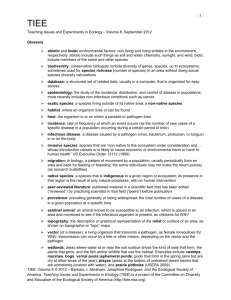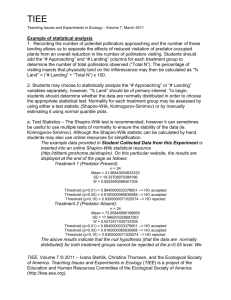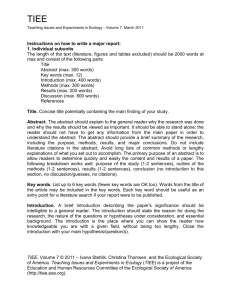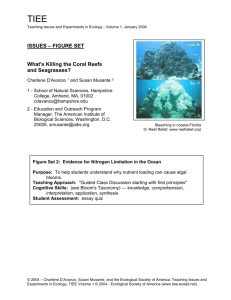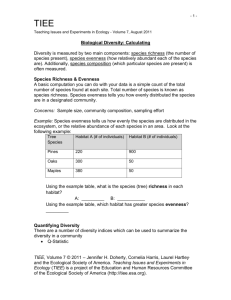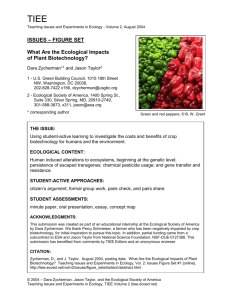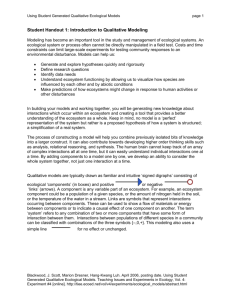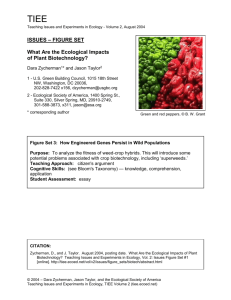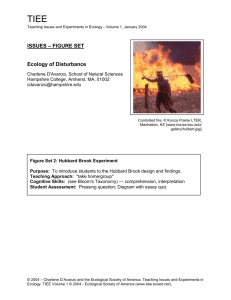DOC version - Ecological Society of America
advertisement
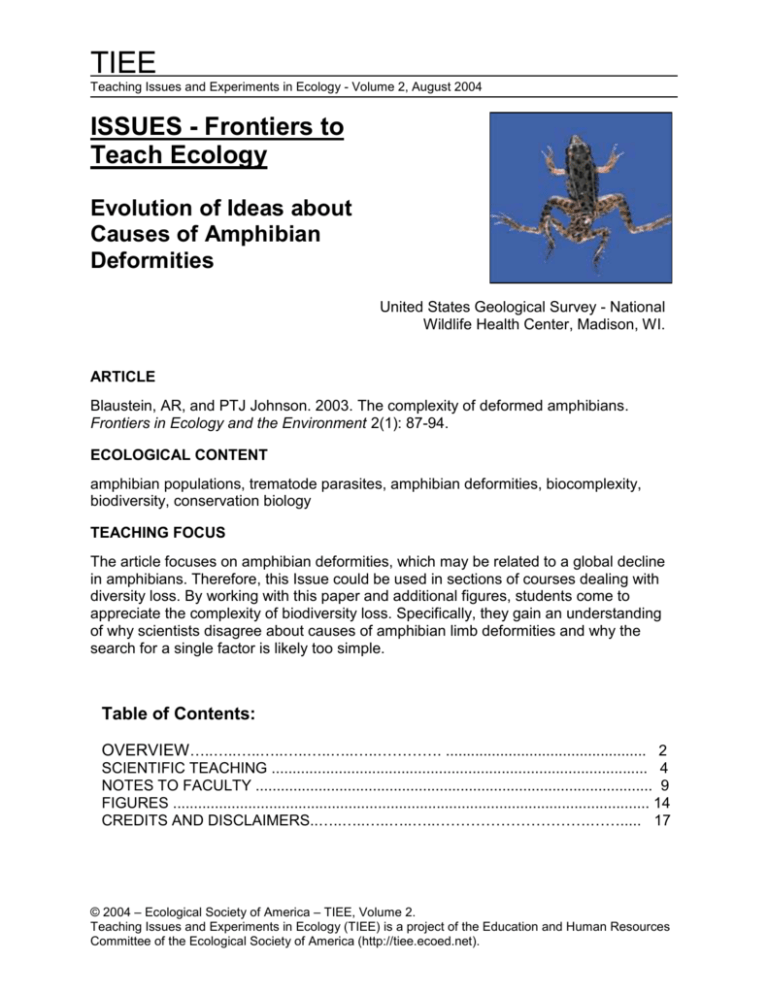
TIEE Teaching Issues and Experiments in Ecology - Volume 2, August 2004 ISSUES - Frontiers to Teach Ecology Evolution of Ideas about Causes of Amphibian Deformities United States Geological Survey - National Wildlife Health Center, Madison, WI. ARTICLE Blaustein, AR, and PTJ Johnson. 2003. The complexity of deformed amphibians. Frontiers in Ecology and the Environment 2(1): 87-94. ECOLOGICAL CONTENT amphibian populations, trematode parasites, amphibian deformities, biocomplexity, biodiversity, conservation biology TEACHING FOCUS The article focuses on amphibian deformities, which may be related to a global decline in amphibians. Therefore, this Issue could be used in sections of courses dealing with diversity loss. By working with this paper and additional figures, students come to appreciate the complexity of biodiversity loss. Specifically, they gain an understanding of why scientists disagree about causes of amphibian limb deformities and why the search for a single factor is likely too simple. Table of Contents: OVERVIEW…..…..…..…..…..…..…..…..…………. ................................................ 2 SCIENTIFIC TEACHING .......................................................................................... 4 NOTES TO FACULTY ............................................................................................... 9 FIGURES .................................................................................................................. 14 CREDITS AND DISCLAIMERS..…..…..…..…..…..………………………….……..... 17 © 2004 – Ecological Society of America – TIEE, Volume 2. Teaching Issues and Experiments in Ecology (TIEE) is a project of the Education and Human Resources Committee of the Ecological Society of America (http://tiee.ecoed.net). page 2 TIEE Volume 2, August 2004 OVERVIEW Two global environmental concerns, biodiversity loss and increasing numbers of emerging diseases, are the context for a worldwide decline of amphibian populations and large numbers of deformed amphibians. In this article, Blaustein and Johnson give examples of these deformities and describe three possible causes. They propose that trematode infection is the most likely cause of amphibian limb deformation but also acknowledge contradictory evidence and the possibility of interacting causes. Frogs, toads, and other amphibians with extra limbs have long been a rare curiosity. Over the last few decades however, frequency and severity of deformities in frog populations has greatly increased. According to Blaustein and Johnson, frequency of severe deformities (e.g., missing or partly missing limbs, misshapen eyes and tails) is as high as 15-90% in some populations. They state that, since the 1990s, over 60 frog species in the United States, Japan, Canada, and Europe have been identified as “deformed.” The three most likely causes of amphibian deformities are ultraviolet (UV) radiation, chemical contamination, and trematode infection. Blaustein and Johnson discuss each briefly, including physiological mechanisms, types of evidence, and, in their opinion, degree of support for the three proposed agents. Their description of the “pros” and “cons” of each agent is quite useful for students. For example, while frogs exposed to UV-B radiation can develop misshapen limbs, the patterns of deformation recorded in the lab are different from those seen in the field (e.g., no lab experiments resulted in extra limbs which is commonly seen in the field). Blaustein and Johnson favor parasitic trematodes as the likely agent because a combination of laboratory and field experiments plus field observations supports this idea. Trematodes are parasitic flatworms with several hosts for its different life stages. Figure 3 of their article illustrates the following cycle: eggs inside snails develop into aquatic larvae; these then burrow into hind limbs of amphibians where adult trematode worms develop; amphibians are in turn are eaten by wading birds; the trematode then reproduces asexually inside the bird producing eggs that are released into water to be eaten by snails. Perhaps the most convincing evidence for the trematode argument, according to Blaustein and Johnson, is data showing a positive correlation between amphibian infection by the trematode Ribeiroia ondatrae and limb deformity. However, parasites are not the sole agent of amphibian deformities because misshapen frogs have been found where trematodes appear to be absent and some of the deformities (e.g., misshapen eyes) are not caused by parasitic worms. The authors conclude by discussing possible interactions between parasitic infections in amphibians and other stressors. For instance they cite a study linking amphibian deformities, presence of Ribeiroia, and number of highly productive, artificial ponds such as farm ponds for cattle. Perhaps more hosts are becoming parasitized by © 2004 - Ecological Society of America. Teaching Issues and Experiments in Ecology, TIEE © 2004 Ecological Society of America. (tiee.ecoed.net) TIEE: ISSUES Complexity of Deformed Amphibians page 3 trematodes because other environmental factors (in this case use of fertilizers which stimulate algal growth and subsequently more snails in farm ponds) favor success of trematodes. © 2004 - Ecological Society of America. Teaching Issues and Experiments in Ecology, TIEE Volume 2 © 2004 - Ecological Society of America. (tiee.ecoed.net) page 4 TIEE Volume 2, August 2004 SCIENTIFIC TEACHING AND ACTION RESEARCH Although ecology faculty have extensive research training, most do not realize that they can do research in their own courses. This is a different kind of research than we are used to — often not controlled, without replicates, and so on. But it is still research because we can develop hypotheses, ask specific questions based on these hypotheses, and then collect and analyze data which in turn inform the questions and hypotheses. There are numerous journals dedicated to interesting research on teaching (e.g., Journal of Research in Science Teaching). One type of classroom research is called “Action Research.” In this type of research, faculty ask specific questions about their students or their teaching, gain information about these questions, and use this information to learn about teaching and their students in a class in particular. A list of Action Research websites are listed below. Action research is an aspect of “Scientific Teaching” (Handelsman et al. 2004). Below we describe a four-step process which you can use to conduct research on your use of the Frontiers article. The theoretical bases for this TIEE Scientific Teaching are three areas of research on learning (D’Avanzo 2003 a,b): metacognition (knowing what we know), misconceptions (firmly held beliefs that are incorrect) and adult development stage theory (stages that learners are thought to go through as their thinking about a discipline matures). Read more about these theories here. Scientific Teaching with Blaustein and Johnson The classroom research we suggest you do in the context of this article is based on adult development stage theory — specifically that students less experienced with science are surprised that there is uncertainty within the scientific community. As discussed in the “Notes to Faculty” section of this Issue, students with a less mature understanding about the nature of science tend to think in black and white — that if there is disagreement between scientists, one of them has to be right. These students do not appreciate that scientists can disagree for a number of reasons — because they are asking different questions, studying different aspects of the same issue, or interpreting data differently. To study the impact of using the Blaustein and Johnson paper on your students’ understanding of why scientists might disagree, we suggest that you follow these four steps: 1) Pre-test, 2) Teaching, 3) Post-test, and 4) Reflection and Response. Step One: Pre-test — assessing your students’ understanding of uncertainty and disagreement between scientists. The questions and answers below are adapted from “Developing Reflective Judgment” by P.M. King and K.S. Kitchener (1994, p. 2-3). Ask your students to write a brief essay in response to the question in italics below. Explain to them in general terms why you are asking © 2004 - Ecological Society of America. Teaching Issues and Experiments in Ecology, TIEE © 2004 Ecological Society of America. (tiee.ecoed.net) TIEE: ISSUES Complexity of Deformed Amphibians page 5 them to do this, stress that this is not a test, and ask them to write their essays anonymously. Read through the responses and compare the student answers to what an “expert” would say (you, for instance). (You don’t need to give the essays back to the students, but if you decide to do this, don’t “correct” them. Instead, point out positive things to encourage that kind of thinking and writing.) In the next class session, generally report what you learned from their essays (about their understanding of the nature of science) and use this as a lead-in to using the Frontiers paper in class, however you choose to do that (see “Notes to Faculty”). In a small-medium size class, you can read through all of the essays (you are not correcting them — just reading them). In a large class, read a sub-sample. In big classes, logistics of collecting essays like this can be formidable, so come up with a reasonably simple solution. For instance, some faculty with classes of 300 or more students give out index cards in class, allow students 5 minutes to hand write an answer at the end of class (to a projected question), and ask students to drop the cards in boxes placed at the exit doors. Here are answers that a student named Alice gave to a series of questions about chemical additives to foods. Write a brief (about 100-150 words) essay describing your opinion about what Alice says. Do you agree with her? If so, why do you agree? If not, why not? (This is not a quiz; just say what you think.) Question: When two scientists disagree about the safety of chemical additives in foods, does it make sense to you that one of them is right and the other one is wrong? Alice: Yes, I think that this would be the case — that one of them is right. Assuming that person is a good scientist of course. Question: What do you mean? Alice: Well, there is one right answer and the scientist who is right just has to use facts to show that they are right. Then, the other guy would have to be wrong. 2. Step Two: Teaching — use the Blaustein and Johnson article in your class, putting special emphasis on the nature of the disagreements between scientists about causes of deformities. This is the focus on Question #5 in the “Notes to Faculty” section. The point is for students to appreciate why scientists working on this topic might come up with different conclusions. © 2004 - Ecological Society of America. Teaching Issues and Experiments in Ecology, TIEE Volume 2 © 2004 - Ecological Society of America. (tiee.ecoed.net) page 6 TIEE Volume 2, August 2004 3. Step Three: Post-test — The purpose of the post-test is to assess the impact of your teaching on students’ understanding of uncertainty in science. How you do this depends in part, of course, on their pre-test essays. Here are a few ideas: If many students seemed to be back-and-white science thinkers, you could ask students to simply rewrite their essay about the “Alice question.” For homework you could ask students to describe why the scientists studying amphibian deformities that you discussed in class disagreed with each other. Use another CAT (Classroom Assessment Technique) such as the “muddiest point “or “directed paraphrasing” to obtain immediate feedback at the end of your discussion or lecture in which you discuss correlation and causation. On the next exam, add an “extra point” question focused on “why scientists might disagree.” 4. Step Four: Reflection and Response — This is probably the hardest part of the whole process — once you have your “data,” what do you do with it. This kind of evaluation is a way for you to think more deeply about your students’ learning — what you really want them to learn and what inhibits them from achieving this goal. When done well, classroom research like this can help make students’ thinking more transparent — so that you can better design on ways to “get through” to them. The idea is to reflect on their learning as opposed to your teaching. Discussing your findings with a trusted and knowledgeable colleague may be the best thing to do, if you have such a colleague. You could also email one of the TIEE editors or post a question on Ecolog (ECOLOG-L@LISTSERV.UMD.EDU), a discussion forum used by ecology faculty). What you do in the class, of course, depends on what you have learned and also the time you can spend on follow-up. At a minimum, in the next class session you should report back to the students and give an overview of their writings — good points and ones many missed — and use this as a way to discuss again the process of science and scientific uncertainty. © 2004 - Ecological Society of America. Teaching Issues and Experiments in Ecology, TIEE © 2004 Ecological Society of America. (tiee.ecoed.net) TIEE: ISSUES Complexity of Deformed Amphibians page 7 If students made good progress between the pre and post-tests, say so and praise them. Don’t expect a big change; modest growth as a result of one class session is a real achievement. REFERENCES D’Avanzo, C. 2003a. Application of research on learning to college teaching: ecological examples. BioScience 53: 1121-1128. D’Avanzo, C. 2003b. Research on learning: Potential for improving college science teaching. Frontiers for Ecology and the Environment 1: 533-540. Handelsman, J. et al. 2004. Scientific Teaching. Science 304: 521-522. King, P.M. and K.S. Kitchener. 1994. Developing Reflective Judgment. JosseyBass, San Francisco. RESOURCES General Handelsman, J., D. Ebert-May, R. Beichner, P. Bruns, A. Chang, R. DeHaan, J. Gentile, S. Lauffer, J. Stewart, S. M. Tilghman, and W. B. Wood. 2004. Scientific Teaching, Science. 304: 521-522. Action Research Good overview and history of action research (http://www.infed.org/research/b-actres.htm) Overview with focus on curriculum development (http://informationr.net/ir/1-1/paper2.html) San Jose State University; brief overview and ideas for how to start (http://www.accessexcellence.org/21st/TL/AR/) University of Colorado site; has many articles (http://carbon.cudenver.edu/~mryder/itc/act_res.html) Reflective Judgment King, P.M. article titled “How Do We Know? What Do We Believe? Learning to Make Reflective Judgments” — King explains the King & Kitchener model (http://www-honors.ucdavis.edu/fh/aa/king.html). © 2004 - Ecological Society of America. Teaching Issues and Experiments in Ecology, TIEE Volume 2 © 2004 - Ecological Society of America. (tiee.ecoed.net) page 8 TIEE Volume 2, August 2004 Great article titled “A Nudge is Best Helping Students Through the Perry Scheme of Intellectual Development” by R.J. Kloss, Professor of English at William Paterson College (http://www-honors.ucdavis.edu/fh/ct/kloss.html). Nice overview titled: “What is Reflective Judgment and Why is it Important?” (http://www-honors.ucdavis.edu/fh/aa/RJO.html) with references. Brief overview, includes discussion of King and Kitchener (http://ldt.stanford.edu/ldt1999/Students/cmazow/MajorProject/onRefThink.htm) Short essay on student intellectual development (http://articles.findarticles.com/p/articles/mi_m0NKR/is_3_89/ai_109131868) PDF of article titled “Students learning to teach: conversing with students about their epistemological beliefs” (http://www.ecu.edu.au/conferences/herdsa/main/papers/ref/pdf/Brownlee.pdf) © 2004 - Ecological Society of America. Teaching Issues and Experiments in Ecology, TIEE © 2004 Ecological Society of America. (tiee.ecoed.net) TIEE: ISSUES Complexity of Deformed Amphibians page 9 NOTES TO FACULTY The emphasis in TIEE Issues is use of figures and tables for discussion and other types of student-active teaching and learning. These notes will give you ideas about using the figures in this paper in your ecology class. The Student-Active Teaching table will introduce you to a variety of approaches you can use in your class to actively engage your students. To see an essay on leading good discussions, go to Guided Class Discussions. Blaustein and Johnson’s paper This is an interesting paper that is quite accessible to undergraduates. You can use it to teach several ecological topics including the life cycle of a parasite involving several animal hosts, causes for biodiversity loss, and the concept of interaction between environmental and biological variables in an ecological system. The amphibian deformity question will intrigue students for several reasons. First, seeing pictures (see resources) of the deformities is just interesting (and for some, gross at the same time). Stories about school children finding deformed frogs and bringing the issue to national attention please students as well. Second, this is a puzzle about which scientists disagree and puzzles pique our curiosity. Many students may well be surprised that good scientists working on the same phenomenon can disagree. Most students have an immature understanding of the nature of scientific study; they are inclined to think that there are right and wrong answers to questions and that in a scientific disagreement one scientist is right and the other wrong. This paper allows these students to begin to appreciate the grey, i.e., differences of opinion may exist because of the different types of evidence examined. (To get at the “why scientists might disagree” issue, you can use some of the questions below to stimulate discussion about the types of data ecologists use as supporting evidence and the observations and data that contradict each argument.) Finally, students are drawn to questions about loss of diversity and most relate positively to frogs and other amphibians. This paper can help students better understand the complexity of species loss, which in many cases is not due to a single cause that can be fixed. The concept of interactions is important in ecology but difficult for some students to grasp. The examples of interactions here are concrete and readily understandable. They can help students appreciate why loss of diversity can accelerate with time. Tips on how to use this Issue Focus on some aspect of this Issue (e.g., lab versus field evidence) and select a figure or discussion question dealing with this point. Then select a teaching © 2004 - Ecological Society of America. Teaching Issues and Experiments in Ecology, TIEE Volume 2 © 2004 - Ecological Society of America. (tiee.ecoed.net) page 10 TIEE Volume 2, August 2004 approach. The Table of Student-Active Approaches includes suggestions for all class sizes. Comments about the figures Blaustein and Johnson’s paper does not contain numerically-based figures. I find that discussion of figures is an effective way to engage students more deeply in an ecological question. In addition, describing and interpreting figures helps students better understand the process of science and gives them more confidence about their skill with data. (See Figure Sets Overview for more about this). I have therefore included three figures in the “Figure” section. The first, Johnson Figure 1, from Johnson et al. 1999, has two panels. Panel A shows the inverse relationship between trematode (Ribeiroia sp.) density in tadpoles of the frog Hyla regilla and tadpole survivorship. Panel B is data from an experiment comparing effects of two different trematodes on Hyla tadpole survivorship and abnormality frequency. These data are strong evidence that Ribeiroia is an agent of the deformities. (The other trematode, Alaria, penetrated tadpoles but did not cause deformities). This is straightforward figure for students to describe and interpret. The second set of figures are from a study by Kiesecker (2002) that links increased trematode infection, limb deformities of woods frogs, (Rana sylvatica), and pesticide exposure (Atrazine, Malathion, and Esfenvalerate). Kiesecker Figure 1 explains the experimental design According to the author, Kiesecker Figure 2 shows that: Exposure to low concentrations of contaminants had dramatic effects on the immune response and rates of cercarial encystment. For each of the three contaminants, exposure increased the proportion of both Ribeiroia sp. and Telorchis sp. that successfully encysted. Likewise, exposure also altered woods frogs’ immune response, as measured by circulating leucocytes. Here I will focus on the response of eosinophils for simplicity and because of the role they play in macroparasite infections. As expected, exposure to pesticides resulted in a decrease in the number of eosinophils circulating in the blood. In the discussion, the author says: My findings support the hypothesis that parasite infection explains the development of limb deformities observed in frog populations in nature. By preventing access of cercariae to the developing amphibians, I was able to prevent developmental abnormalities. These results provide definitive evidence that links deformities under natural conditions to trematode infection. The occurrence of trematode© 2004 - Ecological Society of America. Teaching Issues and Experiments in Ecology, TIEE © 2004 Ecological Society of America. (tiee.ecoed.net) TIEE: ISSUES Complexity of Deformed Amphibians page 11 mediated limb deformities, however, depended on the context of the interaction. Stress in the form of pesticide exposure decreased the host tadpoles’ ability to resist infection, resulting in higher parasite loads and higher risk of limb deformities. Laboratory experiments revealed association between pesticide exposure and increased infection. The decreased immunocompetency associated with pesticide exposure could explain the observed differences in limb deformities at field sites given the link between increased cyst formation and increased limb deformities observed in other studies. However, although chemical contaminants can contribute to the occurrence of deformities, I found that it was necessary for developing amphibians to be exposed to trematode infection for limb deformities to occur. Parasite removal experiments conducted at natural breeding sites, like those conducted in this study, should be used as a first step to assess the etiology of limb deformities. Development of limb deformities in treatments exposed only to trematodes would guide researchers to focus on the role of trematode infection and factors that modify this host–pathogen interaction. However, occurrences of limb deformities in all treatments would then warrant more sophisticated chemical analyses and studies designed to determine which contaminants are responsible for deformities. Note: Kiesecker Figure 2 is more complicated than Kiesecker Figure 1 and will take students more time to figure out. It is a nice example of ecological interactions and how controlled experiments develop from field observations, i.e., deformities were more frequent near agricultural fields. A few definitions: Eosinophils are a type of white blood cell that accumulate during allergic reactions; they play a defense role against parasites. Cercaria are the free swimming form of trematodes. Discussion Questions 1. Amphibians have skin without scales or feathers and eggs without shells. They live in a wide range of habitats. How might these characteristics result in their being “bioindicators” of environmental problems? 2. Amphibian limb deformities may result from interactions between several factors, for example between pesticides and parasite infection. What is meant here by an interaction and how is this important in environmental research on the problem of limb deformation? © 2004 - Ecological Society of America. Teaching Issues and Experiments in Ecology, TIEE Volume 2 © 2004 - Ecological Society of America. (tiee.ecoed.net) page 12 TIEE Volume 2, August 2004 3. Deformed limbs may be a secondary cause of amphibian mortality. Give an example of a primary cause. 4. Three likely causes of amphibian deformities are UV radiation, chemical contamination, and trematode infection. What kinds of field evidence would you look for to support each of these as the causal agent(s)? 5. Scientists disagree about the causes of amphibian limb deformities. For instance, some point to pesticide contamination and others to parasitic trematode infection. Why might scientists disagree about this question? Is one group wrong and the other right? How might you assess this? 6. To assess whether the trematode Ribeiroia sp. caused frog limb deformities, Johnson et al. (1999) exposed tadpoles to Ribeiroia and another trematode Alaria sp. Why did they expose tadpoles to two species of trematode worms? What question were they asking? 7. Most biologists accept the idea that host/parasite interactions often lead to coevolution between the two partners in the relationship. To what degree would parasitic trematodes act as a selective agent to frogs, and would you expect frogs to evolve in response to parasite-induced deformities? What evolutionary significance would you attribute to the fact that some frogs subjected to parasitic infestation do not suffer from deformities? How would you test whether the latter frogs are somehow more evolutionarily “fit” than the ones showing deformities? 8. After reading the Kiesecker paper, examine the manner in which Blaustein and Johnson reported their key findings. Do you believe that Blaustein and Johnson accurately represented the information given by Kiesecker? Did you see any critical points that Kiesecker made in his paper that Blaustein and Johnson overlooked in their review? 9. Some people may perceive that biologists are wasting their time studying limb deformities in frogs. They would argue that intelligent people should focus their energies on other problems like global terrorism, skyrocketing budget deficits, and rampant drug abuse among teenagers. Do you agree with that line of reasoning? Explain your answer. REFERENCES Johnson, P.T.J. et al. 1999. The effect of trematode infection on amphibian limb development and survivorship. Science. 284: 802-804. Kiesecker, J.M. 2002. Synergism between trematode infection and pesticide exposure: A link to amphibian limb deformities in nature? Proceedings of the National Academy of Sciences. 99: 9900-9904. © 2004 - Ecological Society of America. Teaching Issues and Experiments in Ecology, TIEE © 2004 Ecological Society of America. (tiee.ecoed.net) TIEE: ISSUES Complexity of Deformed Amphibians page 13 RESOURCES http://www.pnas.org/cgi/content/full/99/15/9900 Kiesecker, Proceeding of the National Academy of Sciences paper http://www.ourstolenfuture.org/NewScience/wildlife/frogs/20020501johnsonetal.htm An overview of Johnson, PT, KB Lunde, EM Thurman, EG Ritchie, SN Wray, DR Sutherland, JM Kapfer, TJ Frest, J Bowerman and AR Blaustein. 2002. Parasite (Ribeiroia ondatrae) infection linked to amphibian malformations in the western United States. Ecological Monographs 72:151-168; includes two simplified figures you can project for class discussion http://limnology.wisc.edu/pieter/Hidden%20Stuff/Recent%20Publications.html includes PDFs of: o Blaustein, A. R. and P. T. J. Johnson (2003). Explaining frog deformities. Scientific American 288: 60-65. o Blaustein, A. R. and P. T. J. Johnson (2003). The complexity of deformed amphibians. Frontiers in Ecology and the Environment 1: 87-94. o Johnson, P. T. J., Lunde, K. B., Zelmer, D. A. and J. K. Werner (2003). Limb deformities as an emerging parasitic disease in amphibians: Evidence from museum specimens and resurvey data. Conservation Biology 17: 1-14. o Johnson, P. T. J. and D. R. Sutherland (2003). Amphibian deformities and Ribeiroia infection: An emerging helminthiasis. Trends in Parasitology 19: 332-335. o Johnson, P. T. J., Lunde, K. B., Thurman, E. M., Ritchie, E. G., Wray, S. W., Sutherland, D. R., Kapfer, J. M., Frest, T. J., Bowerman, J. and A. R. Blaustein (2002). Parasite (Ribeiroia ondatrae) infection linked to amphibian malformations in the western United States. Ecological Monographs 72: 151-168. o Johnson, P. T. J., Lunde, K. B., Haight, R. W., J. Bowerman, and A. R. Blaustein (2001). Ribeiroia ondatrae (Trematoda: Digenea) infection induces severe limb malformations in western toads (Bufo boreas). Canadian Journal of Zoology 79: 370-379. o Johnson, P. T. J., Lunde, K. B., Ritchie, E. G. and A. E. Launer (1999). The effect of trematode infection on amphibian limb development and survivorship. Science 284: 802-804. http://frogweb.nbii.gov/ USGS’s National Biological Information Initiative site titled “Frogweb: Amphibian Declines and Deformities” http://filebox.vt.edu/users/eengland/DeformedSlides.htm deformed amphibian slide show © 2004 - Ecological Society of America. Teaching Issues and Experiments in Ecology, TIEE Volume 2 © 2004 - Ecological Society of America. (tiee.ecoed.net) page 14 TIEE Volume 2, August 2004 FIGURES Johnson Figure 1 From Johnson, P.T.J. et al. 1999. The effect of trematode infection on amphibian limb development and survivorship. Science. 284: 802-804. © 2004 - Ecological Society of America. Teaching Issues and Experiments in Ecology, TIEE © 2004 Ecological Society of America. (tiee.ecoed.net) TIEE: ISSUES Complexity of Deformed Amphibians page 15 Kiesecker Figure 1 From Kiesecker, J.M. 2002. Summary of the effects of proximity to agricultural runoff (sites 1-3 received inputs of contaminants; sites 4-6 had no detectable levels of contaminants) and exposure to trematode infection (exposed and protected) on limb deformities (proportion exhibiting limb deformities), survival (proportion reaching metamorphosis), and mass (mass at metamorphosis) of wood frogs raised in field enclosures. © 2004 - Ecological Society of America. Teaching Issues and Experiments in Ecology, TIEE Volume 2 © 2004 - Ecological Society of America. (tiee.ecoed.net) page 16 TIEE Volume 2, August 2004 Kiesecker Figure 2. From Kiesecker, J.M. 2002. Synergism between trematode infection and pesticide exposure: A link to amphibian limb deformities in nature? Proceedings of the National Academy of Sciences. 99: 9900- 9904. © 2004 - Ecological Society of America. Teaching Issues and Experiments in Ecology, TIEE © 2004 Ecological Society of America. (tiee.ecoed.net) TIEE: ISSUES Complexity of Deformed Amphibians page 17 CREDITS AND DISCLAIMERS CREDITS FOR THIS EXPERIMENT: This submission was greatly improved by comments from anonymous reviewers. GENERIC DISCLAIMER: The Ecological Society of America (ESA) holds the copyright for TIEE Volume 2, and the authors retain the copyright for the content of individual contributions (although some text, figures, and data sets may bear further copyright notice). No part of this publication may be reproduced, stored in a retrieval system, or transmitted, in any form or by any means, electronic, mechanical, photocopying, recording, or otherwise, without the prior written permission of the copyright owner. Use solely at one's own institution with no intent for profit is excluded from the preceding copyright restriction, unless otherwise noted. Proper credit to this publication must be included in your lecture or laboratory course materials (print, electronic, or other means of reproduction) for each use. To reiterate, you are welcome to download some or all of the material posted at this site for your use in your course(s), which does not include commercial uses for profit. Also, please be aware of the legal restrictions on copyright use for published materials posted at this site. We have obtained permission to use all copyrighted materials, data, figures, tables, images, etc. posted at this site solely for the uses described in the TIEE site. Lastly, we request that you return your students' and your comments on this activity to Susan Musante (tieesubmissions@esa.org), Managing Editor for TIEE, for posting at this site. © 2004 - Ecological Society of America. Teaching Issues and Experiments in Ecology, TIEE Volume 2 © 2004 - Ecological Society of America. (tiee.ecoed.net)
